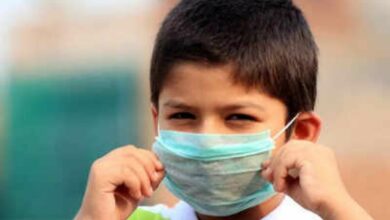Hospitals in Florida, Texas and Arizona Are Almost at Capacity as Coronavirus Cases Surge
The seesaw effect — restrictions lifted, then reimposed — has been seen around the country in recent weeks and is expected again after a holiday that saw crowds of people celebrating, many without masks.
“We were concerned before the weekend and remain concerned post-holiday, as anecdotal stories and observed behavior indicate that many continue to disregard important protective guidance,” said Heather Woolwine, a spokeswoman for the Medical University of South Carolina.
Confirmed cases are on the rise in 41 out of 50 states plus the District of Columbia, and the percentage of tests coming back positive for the virus is increasing in 39 states.
Florida, which recorded an all-time high of 11,400 new cases Saturday and has seen its positive test rate lately reach more than 18%, has been hit especially hard, along with other Sunbelt states such as Arizona, California and Texas.
A virus outbreak in the California Legislature indefinitely delayed the state Assembly’s return to work from a scheduled summer recess. Five people including Assemblywoman Autumn Burke tested positive. Coronavirus hospitalizations in California have increased 56% in the past two weeks while the number of confirmed cases has jumped 53%.
In Miami-Dade County, population 2.7 million, Mayor Carlos Gimenez ordered the closing of restaurants and certain other indoor places, including vacation rentals, seven weeks after they were allowed to reopen. Beaches will reopen on Tuesday after being closed over the weekend.
“But if we see crowding and people not following the public health rules, I will be forced to close the beaches again,” the mayor warned.
Hospitalizations across the state have been ticking upward, with nearly 1,700 patients admitted in the past seven days compared with 1,200 the previous week. Five hospitals in the St. Petersburg area were out of intensive care unit beds, officials said. Miami’s Baptist Hospital had only four of its 88 ICU beds available.
“If we continue to increase at the pace we have been, we won’t have enough ventilators, enough rooms,” said Dr. David De La Zerda, ICU medical director and pulmonologist at Miami’s Jackson Memorial Hospital.
Officials in Texas also reported hospitals are in danger of being overwhelmed. Hospitalizations statewide surged past 8,000 for the first time over the weekend, a more than fourfold increase in the past month. Houston officials said intensive care units there have exceeded capacity.
Along the border with Mexico, two severely ill patients were flown hundreds of miles north to Dallas and San Antonio because hospitals in the Rio Grande Valley were full.
In Arizona, the number of people hospitalized with COVID-19 topped 3,200, a new high, and hospitals statewide were at 89% capacity. Confirmed cases surpassed 100,000, and more than half of those infected, or over 62,000, are under 44 years old, state health officials said.
As cases surge across the state, Katie Cameron said it appears some of her neighbors in Phoenix are in denial. The mother of two said she’s seen people tearing down caution tape meant to keep them off playground equipment in parks, large groups gathering to socialize and — most concerning — very few masks.
“I feel like people don’t care or don’t think its real,” Cameron said. “It’s kind of like ‘out of sight, out of mind’ or they are just lying to themselves because they don’t want to believe it.”
Health officials in South Carolina reported over 1,500 new cases Monday. If the numbers keep rising at their current rates, hospitals will probably have to adopt an emergency plan to add 3,000 more beds in places such as hotels and gyms, authorities said.
Alabama has been averaging about 1,000 new cases a day, two or three times what it was seeing in late April, when its stay-at-home order was lifted.
“We set a record for highs over the holiday weekend, and, of course, given the number of people who were out and about over the weekend celebrating, we are certainly concerned about what the next couple of weeks are going to look like as well,” said Scott Harris, Alabama’s health officer.
In West Virginia, Republican Gov. Jim Justice reversed course and ordered the wearing of face masks indoors, joining other state leaders around the country.
“I’m telling you, West Virginia, if we don’t do that and do this now, we’re going to be in a world of hurt,” he said, adding: “It’s not much of an inconvenience.”
The coronavirus is blamed for over a half-million deaths worldwide, including more than 130,000 in the U.S., according to the tally kept by Johns Hopkins University. The number of confirmed infections nationwide stood at 2.9 million, though the real number is believed to be 10 times higher.
New cases per day nationwide have hit record levels of well over 50,000.
Average deaths per day have fallen over the past two weeks from around 600 to about 510, in what experts say reflects advances in treatment and prevention as well as the large share of cases among young adults, who are more likely than older ones to survive COVID-19.
But deaths are considered a lagging indicator — that is, it takes time for people to get sick and die. And experts are worried the downward trend in deaths could reverse itself.
Meanwhile, three of the top U.S. medical organizations issued an open letter urging Americans to wear masks, social distance and wash hands often to help stop “the worst public health crisis in generations.”
The American Medical Association, American Nurses Association and American Hospital Association issued the plea in the absence of a mask-wearing order from Washington and said steps taken early on that helped slow the spread of COVID-19 “were too quickly abandoned.”
The White House again rejected calls for a nationwide order to wear face coverings, with White House chief of staff Mark Meadows saying on Fox News that it is a matter for governors and mayors to decide.
In New York, once the most lethal hot spot in the country, Gov. Andrew Cuomo said he was concerned about reports of large gatherings over the holiday weekend in New York City, on Fire Island and other places.
“I understand people are fatigued,” he said. “We’ve been doing this for 128 days. I get it. But it doesn’t change the facts, and we have to stay smart.”
Source: Time






